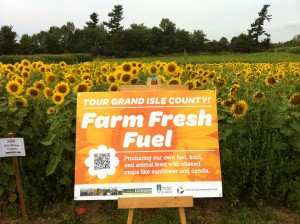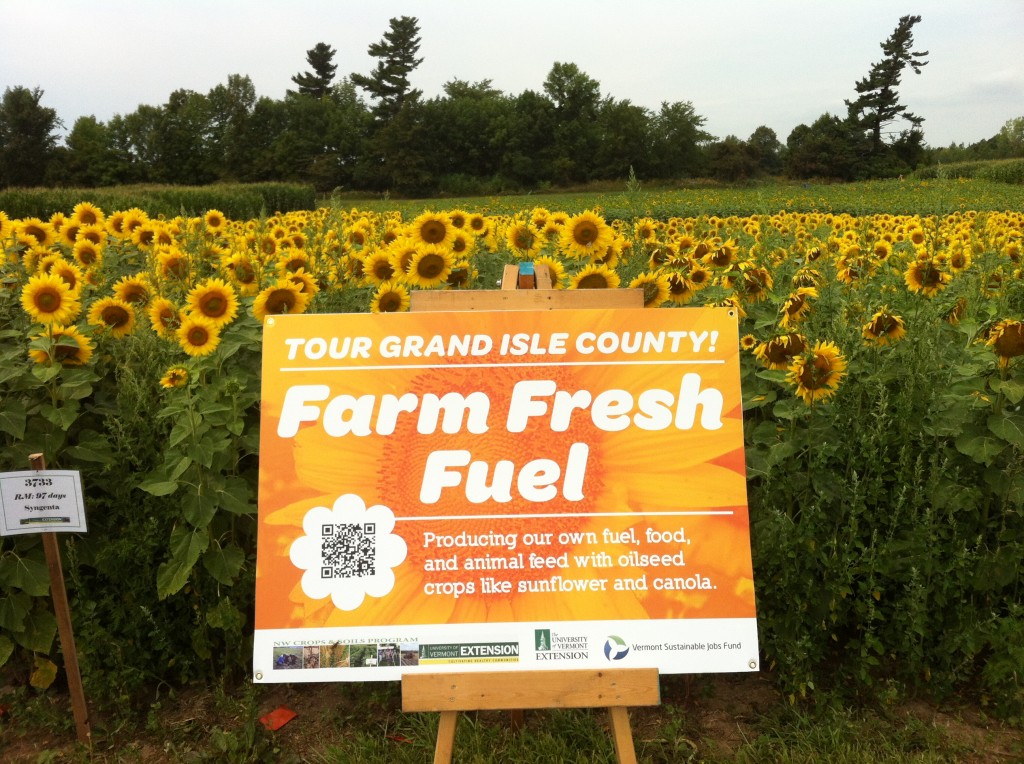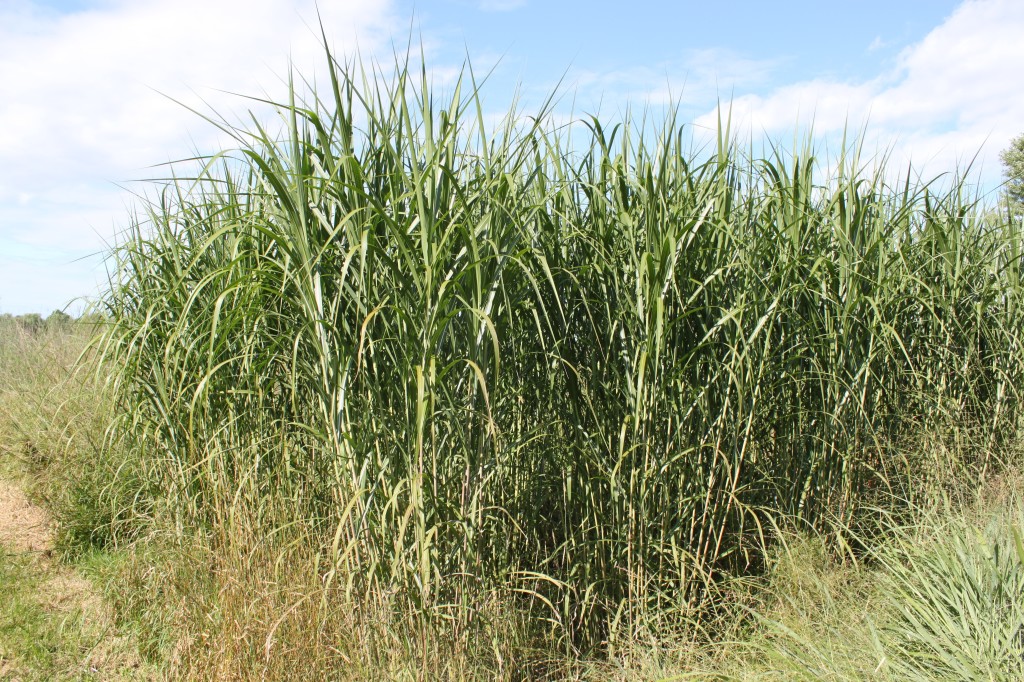10 Jul 2013
Green Mountain Spark, LLC
As an alternative to biodiesel, Green Mountain Spark (GMS) with the support of the University of Vermont (UVM) Chemistry Department is optimizing a chemical conversion process for the decarboxylation of vegetable oils to generate a new green diesel fuel. The chemical structure of the hydrocarbon fuel products formed from the decarboxylation process is very similar to compounds present in conventional petrodiesel, allowing easy adoption of this fuel (green diesel) into existing infrastructure. Compared to biodiesel, this fuel will have improved fuel storage and transportation properties as well as superior cold weather characteristics.
Read More

A roadside sign informs passerby of the Farm Fresh Fuel project in Grand Isle County, Vermont. Photo credit: VSJF
A small revolution is happening in Grand Isle County, a declaration of fuel independence: In 2012, ten farmers and landowners tried their hand at growing sunflowers to have the oil made into biodiesel to fuel farm equipment or heat their homes.
Many farmers want to diversify their operation, control and lower fuel costs, and become more self-sufficient. Additionally, locally-grown renewable energy will support the agriculture economy. In Grand Isle County, growing their own biodiesel can save farmers more than $2.00 per gallon, according to a new study released by the Vermont Sustainable Jobs Fund (See the report, Vermont On-Farm Oilseed Enterprises: Production Capacity and Breakeven Economics). Emerging feedstocks and new technology takes know-how, and the Vermont Bioenergy Initiative (VBI) at Vermont Sustainable Jobs Fund is taking steps to overcome barriers to energy self-sufficiency on the farm.
With funding from the U.S. Department of Energy, Borderview Farm staff and UVM Extension researchers guided the planting, tending, and harvesting of more than 60 acres of sunflowers in the 2012 growing season for the Grand Isle Farm Fresh Fuels Project. Each farmer planted two to ten acres of sunflowers, growing more than 30 tons of sunflower seeds. The seeds will be pressed into 3,000 gallons of renewable, low-emission biodiesel and 26 tons of oilseed meal to feed livestock or use as pellet fuel.
For the UVM researchers, coordinating the project, overcoming some of the logistical challenges, and shepherding a successful crop of sunflowers into the storage bin at Roger Rainville’s farm was all part of the job. The lessons learned this year in Grand Isle County also contribute to a growing body of knowledge that is helping farmers in other regions put more acres under oilseed production and save money on their fuel bills.
To learn more about the Farm Fresh Fuel project, visit the UVM website and the Oilseeds section of this website.
08 Jul 2013
What is the Vermont Bioenergy Initiative?
The Vermont Bioenergy Initiative (VBI) is working to replace a portion of the fossil fuel energy consumed in-state with homegrown alternatives from oilseed crops, perennial grasses and algae. Our grant making and technical assistance are aimed at addressing the most critical issues of our time — peak oil, energy price volatility, and climate change – using an innovative ‘local production for local use’ market development model.
The Vermont Bioenergy Initiative supports the expansion of the supply of and demand for locally produced and commodity-level biofuels in Vermont in order to reduce the state’s dependency on petroleum. By providing grant funding and technical assistance to new businesses, VBI promotes entrepreneurial activity in the emerging biofuels sector that will eventually create livable wage jobs. Further, stimulating farm-based biofuels and bioenergy production enhances farm viability and thereby local food security. In addition to grant-making and technical assistance, VBI helps to educate the public about the benefits of sustainably- and locally-produced bioenergy feedstocks and fuels.
08 Jul 2013
What is Bioenergy?
The term “Bioenergy” refers to renewable energy fuels and feedstocks derived from biological sources; these can be agricultural biomass, liquid biofuels, and biogas used for heat, electricity, combined heat and power, or vehicle fuel. The term is often used synonymously with “biofuels.”
Some examples of bioenergy feedstocks and fuels being developed in Vermont include switchgrass, hay and other agricultural biomass for heat and power; oilseeds (like canola, sunflower and soybean) and algae for biodiesel; animal waste and food scraps for anaerobic digesters and captured landfill gas to create electricity and biomethane.
While there are a variety of bioenergy feedstocks and fuels, there are three primary focus areas for VBI: Algae, Grass, and Oilseeds.
Algae: Microalgae such as green algae and diatoms can be grown and pressed for oil, fuel, feed, food and fertilizer.
Grass: Perennial grasses like switchgrass, big bluestem, reed canarygrass, and Miscanthus can be grown and compressed into pellets or briquettes for use as heating fuel.
Oilseeds: Oilseeds such as sunflower, soybean, and canola can be grown and pressed for oil that can be made into food-grade cooking oil or biodiesel. The leftover meal is a co-product that can be used for livestock feed and organic fertilizer.
Click here to read more about the Vermont Bioenergy Initiative.









